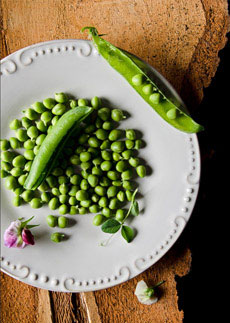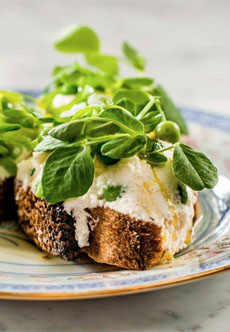TIP OF THE DAY: Ways To Use Fresh Spring Peas
|
Lovers of green peas (also called English peas and garden peas), you’re in for a treat. Spring is the season.
It’s time to serve sides of fresh-steamed green peas and make some delicious fresh pea soup. But what else should you be doing with these bright green jewels? Their sweet flavor and bright color can grace your table in so many other ways. You can use almost any cooking method, from boiling, braising or microwaving, to sautéing, steaming and stir-frying. Add them raw to salads and pop them into your mouth as a snack. They take only a few minutes to cook. In fact, you need to watch them to avoid ending up with mushy peas (if this happens, make a quick pea purée; and if they’ve lost their bright hue, add a teeny drop of food color). We aim for “al dente.” Create recipes with these flavor accents: |
Fresh picked and divine. Photo courtesy The Chef’s Garden. |
|
|
Don’t dally: The season is short! For inspiration, here are just ways to use the bounty of fresh peas. |
||
|
|
GREEN PEAS AT DINNER |
|
|
RECIPE: GREEN PEA & RICOTTA TOAST Enjoy this for breakfast, as a first course or a snack. We chose a rustic Italian loaf with sesame seeds, but any peasant bread will do. Ingredients 1. STEAM the peas to al dente and let cool. Combine the ricotta with salt, pepper and lemon zest to taste. Stir in peas to taste (few or many). 2. TOAST the bread and slice as desired (depending on the diameter of the loaf, cut the toast into manageable pieces). 3. SPREAD toast with the pea-ricotta mixture. Drizzle with extra virgin olive oil. Garnish and serve. Buying Fresh Peas For the best flavor, choose small peas. They’re younger, sweeter and more tender than large ones. Look for medium-size pods that are firm and green, with no yellowing. Break open a pod and check the peas. They should be small, bright green and firm. Taste the peas in the pod: They should be tender and sweet. Freshness counts. As with corn, once picked the peas’ high sugar content begins to convert to starch. Don’t pay for mature peas. You might as well use frozen peas. Don’t pay extra for shelled peas. You don’t know how fresh they are; and since you aren’t shelling peas day in, day out, it’s a fun activity. The pea is native to western Asia and North Africa, and are one of the oldest cultivated foods, dating to the beginning of agriculture in the Middle East (as long as 10,000 years ago [8000 B.C.E.). By 2000 B.C.E., pea cultivation had spread throughout Europe and east into India. By the first century C.E., peas were introduced to China and soon after 1492, to the New World. Along with broad beans and lentils, peas were a staple for most Europeans during the Middle Ages. By the 1600s and 1700s, it became popular pick and eat immature peas. In France and England, where the eating of green peas eating young peas became a fashion. New varieties of peas were developed by the English during this time, including the familiar green peas we call garden peas and English peas. Thomas Jefferson grew more than 30 varieties of peas at Monticello. As the process of canning food became widespread in the 19th century, green peas moved beyond spring and became available year-round [source]. Clarence Birdseye introduces the first frozen peas in 1952, which, everyone can agree, enabled a semblance of fresh peas year-round. |
||

